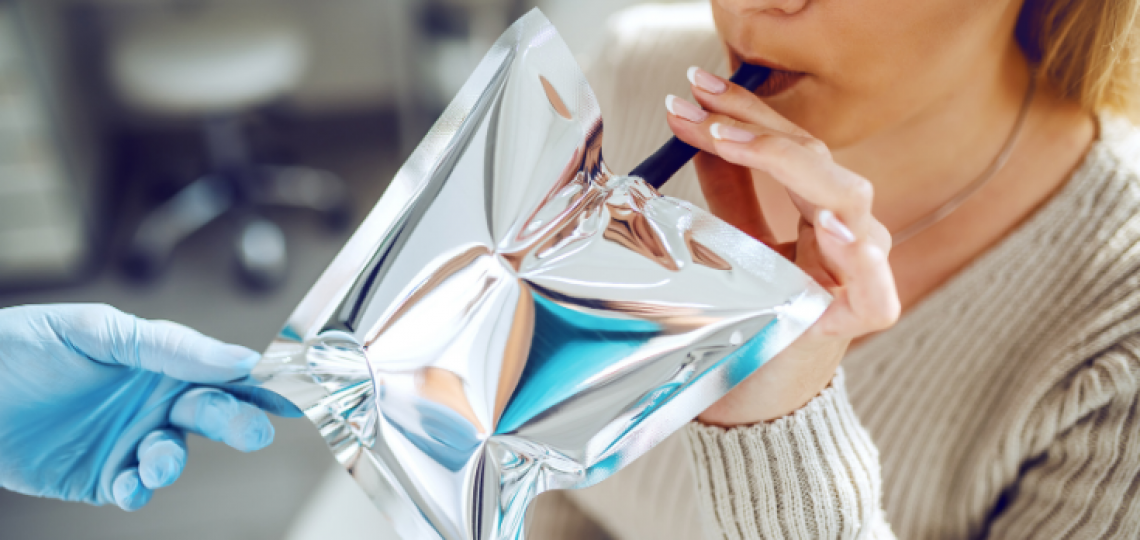
Breath Testing
Breath testing involves the collection of breath samples to measure specific gases in the exhaled air and may be used to diagnose several different gastrointestinal conditions. Despite similar steps for all breath testing – preparation, baseline collection of breath samples, ingestion of a meal or solution, and additional collection of breath samples – the specifics of these steps vary for each type of breath testing.
Helicobacter Pylori Breath Testing
Helicobacter pylori (“H.pylori”) is a common infection that can cause ulcers of the stomach and small intestine, gastritis, and less commonly, stomach cancer. Breath testing can be used to diagnose H.pylori, as well as to document that treatment has gotten rid of it.
Breath testing for Helicobacter pylori involves fasting for 1-2 hours before the test, collecting a baseline breath sample, and then consuming about 5 ounces of specific solution. If H.pylori is present in the stomach, it will break down the test solution and radiolabeled carbon dioxide (13C) will be released into the breath.
The test is the shortest of the various breath tests (10 to 20 minutes).
It is important to discuss medications with your doctor before the test, as no proton pump inhibitors (omeprazole, lansoprazole, rabeprazole, dexlansoprazole, etc.), antibiotics, or bismuth-containing preparations such as Pepto Bismol ®) can be used within 2 weeks of the test.
The test solution does contain aspartame, which may cause harm to patients with phenylketonuria (PKU), a rare genetic condition in which aspartame breakdown products can cause neurologic and other problems.
Specific Sugar (Fructose and Lactose) Breath Testing
Breath testing can be used to test for malabsorption of specific sugars, namely fructose (which is most common in fruits, onions, artichokes, wheat) and lactose (which is in milk and dairy products).
Preparation includes a diet low in fiber and nonabsorbable carbohydrates (starches and sugars) the day before the test. Fast for 12 hours prior to the test. Avoid testing until 4 weeks after completing antibiotics, probiotics, and bowel preparations for colonoscopy.
Baseline breath samples will be collected, followed by ingestion of a fructose (25 grams) or lactose (50 grams) containing beverage. Breath samples will then be collected every 15 minutes for up to 2 to 4 hours, with measurement of hydrogen in the breath samples. Increased hydrogen indicated that the body cannot breakdown and absorb fructose or lactose normally and indicates intolerance.
Small Intestine Bacterial Overgrowth (SIBO)
SIBO is a common condition involving and overgrowth of bacteria in the small intestine leading to fermentation of sugars and symptoms such as bloating, gas, pain, and diarrhea. There are many risk factors for SIBO, and some patients with irritable bowel syndrome (IBS) may have overlapping symptoms with SIBO and/or SIBO as a driving force behind their IBS symptoms.
Preparation for breath testing for SIBO involves following a specific diet the day before the test, followed by an overnight fast. A baseline sample is collected, followed by consumption of 100 grams of glucose or 10 grams of lactulose). Breath samples are then collected every 15 minutes for 4 hours. Hydrogen and methane in the exhaled samples are measured, with increases in either potentially suggestive of excess bacteria in the small bowel fermenting the glucose drink.
13C-Spirulina Gastric Emptying Breath Test
The 13C-Spirulina Gastric Emptying Breath Test is a safe, FDA-approved, non-radioactive test to help diagnose delayed/slow emptying of the stomach known as gastroparesis.
Preparation for the test involves an overnight fast. The day of the test, pre-meal breath samples are collected. Then, a special meal with Spirulina (an algae-based supplement), egg, and saltine crackers is consumed which contains a compound, carbon-13 (13C), which can be detected in the breath as carbon dioxide (CO2). The better the stomach empties, the more of the meal is absorbed and the more 13C is exhaled in the breath. Post-meal breath samples are collected at 6 times over 4 hours and submitted to the lab for analysis.
The test should be avoided in individuals allergic to any of the components of the meal, or in those with small bowel malabsorption.








